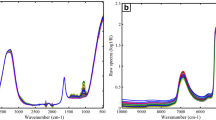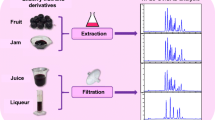Abstract
A fast method for the simultaneous quantitative determination of 16 phenolic compounds in grape juice by UPLC-MS was developed and validated. Run time was 4.5 min and the method proved to be specific, linear (r > 0.9961), precise (RSD < 5%), accurate (recovery range was under ± 5%) and sensitive with a limit of detection ranging from 0.45 to 35.34 μg L−1 and limit of quantification ranging from 1.35 to 107.08 μg L−1. The validated method was used to characterize 49 grape juice samples which were produced with different grape varieties. Anthocyanins were the compounds present in the highest amounts on the analyzed samples and BRS-Violeta was the cultivar that presented the highest quantity of phenolic compounds in its juice. Exploratory analysis of the obtained results from the characterization of grape juice samples was performed and a tendency to form groups according to the grape variety used in the elaboration of each juice was observed. Results confirmed that the UPLC-MS method is effective and suitable for the determination of phenolic compounds in grape juice.





Similar content being viewed by others
Data availability
The authors declare that the data supporting the findings of this study are available within the article and its supplementary information files. Additional raw data are available from the corresponding author on request.
Code availability
Not applicable.
References
C. Rice-Evans, Antioxidant Food Supplements in Human Health, 1st edn. (Academic Press, San Diego, 1999), p. 496
O. Sorg, C.R. Biologies 327, 649 (2004)
P.R.B. Evora, P.J. Pearson, J.F. Seccombe, H.V. Schaff, Arq. Bras. Cardiol. 66, 7 (1996)
M. Valko, D. Leibfritz, J. Moncol, M.T.D. Cronin, M. Mazur, J. Telser, IJBCB 39, 44 (2007)
A. Crozier, M.N. Clifford, H. Ashihara, Plant Secondary Metabolites: Occurrence, Structure and Role in the Human Diet (Blackwell Publishing, Oxford, 2006)
R.A. Dixon, N.L. Paiva, Plant Cell 7, 1085 (1995)
C.C. Guerra, Revista Brasileira de Viticultura e Enologia 4, 90 (2012)
J. López-Hernández, A.R.-B. de Quirós, IJMS 17, 1769 (2016)
M.M.P. Natividade, L.C. Corrêa, S.V.C. de Souza, G.E. Pereira, L.C. de Oliveira Lima, Microchem. J. 110, 665 (2013)
C.V. da Silva Padilha, G.A. Miskinis, M.E.A.O. de Souza, G.E. Pereira, D. de Oliveira, M.T. Bordignon-Luiz, M. dos Santos Lima, Food Chem. 228, 106 (2017)
L.F. da Silva, C.C. Guerra, D. Klein, A.M. Bergold, Food Chem. 227, 158 (2017)
L. Snopek, J. Mlcek, L. Sochorova, M. Baron, I. Hlavacova, T. Jurikova, R. Kizek, E. Sedlackova, J. Sochor, Molecules 23, 1684 (2018)
A. Stalmach, C.A. Edwards, J.D. Wightman, A. Crozier, J. Agric. Food Chem. 59, 9512 (2011)
A.P. Whelan, W.H.F. Sutherland, M.P. McCormick, D.J. Yeoman, S.A. De Jong, M.J.A. Williams, Intern. Med. J. 34, 224 (2004)
L.A. Rizzon, J. Meneguzzo, Suco de Uva, 1st edn. (Embrapa Informação Tecnológica, Brasília, 2007)
U.A. Camargo, Isabel Precoce—Alternativa Para a Vitivinicultura Brasileira. Comunicado Técnico 54, 1st edn. (Embrapa Uva e Vinho, Bento Gonçalves, 2004)
U.A. Camargo, J.D.G. Maia, J.C. Nachtigal, BRS-Violeta—Nova Cultivar de Uva Para Suco e Vinho de Mesa. Comunicado Técnico 63, 1st edn. (Embrapa Uva e Vinho, Bento Gonçalves, 2005)
A. Hoffman, U.A. Camargo, J.D.G. Maia, Sistema de Produção de Uvas Rústicas para Processamento em Regiões Tropicais do Brasil. Embrapa (2005). Retrieved from https://sistemasdeproducao.cnptia.embrapa.br/FontesHTML/Uva/UvasRusticasParaProcessamento/index.htm
P. Ritschel, J.D.G. Maia, U.A. Camargo, M.C. Zanus, R.T. de Souza, T.V.M. Fajardo, BRS-Magna—Nova Cultivar de Uva Para Suco Com Ampla Adaptação Climática. Comunicado Técnico 125, 1st edn. (Embrapa Uva e Vinho, Bento Gonçalves, 2012)
P. Marchi, A.P.R. Paiotti, R.A. Neto, C.T.F. Oshima, D.A. Ribeiro, Environ. Toxicol. Pharmacol. 37, 819 (2014)
D. Shanmuganayagam, T.F. Warner, C.G. Krueger, J.D. Reed, J.D. Folts, Atherosclerosis 190, 135 (2007)
L.T. Toscano, R.L. Tavares, L.T. Toscano, C.S.O. da Silva, A.E.M. de Almeida, A.C.T. Biasoto, M. da Conceição Rodrigues Gonçalves, A.S. Silva, Appl. Physiol. Nutr. Metab. 40, 899 (2015)
J.A. Vinson, K. Teufel, N. Wu, Atherosclerosis 156, 67 (2001)
FAO-OIV, Table and Dried Grapes- Non-Alcoholic Products of the Vitivinicultural Sector Intended for Human Consumption. FAO-OIV FOCUS 2016 (Food and Agriculture Organization of the United Nations and International Organisation of Vine and Wine, Roma, 2016)
L.M.R. de Mello, Vitivinicultura Brasileira: Panorama 2017. Comunicado Técnico 207, 1st edn. (Embrapa Uva e Vinho, Bento Gonçalves, 2018)
OIV, 2018 World Vitiviniculture Situation. OIV Statistical Report on World Vitiviniculture (International Organisation of Vine and Wine, Paris, 2018)
OIV, Compendium of International Methods of Wine and Must Analysis (International Organisation of Vine and Wine, Paris, 2019)
C. Dani, L.S. Oliboni, R. Vanderlinde, D. Pra, J.F. Dias, M.L. Yoneama, D. Bonatto, M. Salvador, J.A.P. Henriques, J. Med. Food 12, 188 (2009)
D. Fracassetti, N. Lawrence, A.G.J. Tredoux, A. Tirelli, H.H. Nieuwoudt, W.J. Du Toit, Food Chem. 128, 1136 (2011)
M.-C. Menet, Revue Francophone des Laboratoires 2011, 41 (2011)
D.A. Skoog, D.M. West, F.J. Holler, S.R. Crouch, Fundamentals of Analytical Chemistry, 9th edn. (Cengage, Boston, 2014)
C.C. Guerra, H. Bitarelo, R.L. Ben, A. Marin, Sistema Para Elaboração de Suco de Uva Integral Em Pequenos Volumes: Suquificador Integral. Documentos, 96, 1st edn. (Embrapa Uva e Vinho, Bento Gonçalves, 2016)
V. Marzarotto, in Bebidas Não-Alcoólicas: Ciência e Tecnologia, 1st edn., ed. by W.G. Venturini FIlho (Edgar Blücher, São Paulo, 2010), p. 385
ICH, Validation of Analytical Procedures: Text and Methodology Q2(R1) (International Conference On Harmonisation Of Technical Requirements For Registration Of Pharmaceuticals For Human Use, 2005).
BRASIL, Ministério Da Saúde—MS. Agência Nacional de Vigilância Sanitária—ANVISA. Resolução Da Diretoria Colegiada—RDC No 166, de 24 de Julho de 2017 (2017)
G.A. Helfer, F. Bock, L. Marder, J.C. Furtado, A.B. da Costa, M.F. Ferrão, Quím. Nova 38, 575–579 (2015)
M.G. Cardozo, N. Medeiros, D. dos Santos Lacerda, D.C. de Almeida, J.A.P. Henriques, C. Dani, C. Funchal, Cell. Mol. Neurobiol. 33, 1123 (2013)
C. Dani, L.S. Oliboni, R. Vanderlinde, D. Bonatto, M. Salvador, J.A.P. Henriques, Food Chem. Toxicol. 45, 2574 (2007)
M.D.C.P. Dutra, L.L. Rodrigues, D. de Oliveira, G.E. Pereira, M. dos Santos Lima, Food Chem. 269, 157 (2018)
A. Ananga, V. Georgiev, J. Ochieng, B. Phills, V. Tsolova, in Production of anthocyanins in grape cell cultures: a potential source of raw material for pharmaceutical, food, and cosmetic industries, ed. by B. Sladonja, D. Poljuha. The Mediterranean Genetic Code—Grapevine and Olive (IntechOpen, 2013), p. 247–287. https://doi.org/10.5772/3442
Ø.M. Andersen, K.R. Markham (eds.), Flavonoids: Chemistry, Biochemistry, and Applications (CRC, Taylor & Francis, Boca Raton, 2006)
Genomenet (2019). Retrieved from https://www.genome.jp/
H. Maeda, N. Dudareva, Annu. Rev. Plant Biol. 63, 73 (2012)
T.A. Holton, E.C. Cornish, Plant Cell 7, 1071 (1995)
F. He, L. Mu, G.-L. Yan, N.-N. Liang, Q.-H. Pan, J. Wang, M.J. Reeves, C.-Q. Duan, Molecules 15, 9057 (2010)
K.G. Martino, M.S. Paul, R.B. Pegg, W.L. Kerr, LWT Food Sci. Technol. 53, 327 (2013)
K. Sólyom, R. Solá, M.J. Cocero, R.B. Mato, Food Chem. 159, 361 (2014)
M. dos Santos Lima, I.D.S.V. Silani, I.M. Toaldo, L.C. Corrêa, A.C.T. Biasoto, G.E. Pereira, M.T. Bordignon-Luiz, J.L. Ninow, Food Chem. 161, 94 (2014)
R.G. Brereton, Chemometrics: Data Analysis for the Laboratory and Chemical Plant, 1st edn. (Wiley, Chichester, 2003)
Acknowledgements
The authors would like to acknowledge the financial support from the Brazilian Coordination for the Improvement of Higher Education Personnel (CAPES—Coordenação de Aperfeiçoamento de Pessoal de Nível Superior) and Pharmaceutical Sciences Graduate Program of the Federal University of Rio Grande do Sul (PPGCF-UFRGS—Programa de Pós-Graduação em Ciências Farmacêuticas da Universidade Federal do Rio Grande do Sul). They are also grateful to the Brazilian Agricultural Research Corporation (Embrapa—Empresa Brasileira de Pesquisa Agropecuária) for providing laboratory infrastructure and grape juice samples.
Funding
The authors would like to acknowledge the financial support from the Brazilian Coordination for the Improvement of Higher Education Personnel (CAPES—Coordenação de Aperfeiçoamento de Pessoal de Nível Superior) and Pharmaceutical Sciences Graduate Program of the Federal University of Rio Grande do Sul (PPGCF-UFRGS—Programa de Pós-Graduação em Ciências Farmacêuticas da Universidade Federal do Rio Grande do Sul).
Author information
Authors and Affiliations
Corresponding author
Ethics declarations
Conflict of interest
The authors declare that they have no competing financial interests or personal relationships that could have appeared to influence the work reported in this paper.
Ethical approval
Not applicable.
Consent to participate
Not applicable.
Consent for publication
Not applicable.
Additional information
Publisher's Note
Springer Nature remains neutral with regard to jurisdictional claims in published maps and institutional affiliations.
Electronic supplementary material
Below is the link to the electronic supplementary material.
11694_2020_706_MOESM1_ESM.xlsx
Online Resource 1 Concentration of phenolic compounds, in mg L-1, in grape juice samples. <LOQ: under limit of quantification. ND: not detected. Each value represents mean (n=3) ± standard deviation. Compounds: cyanidin-3,5-diglucoside (CY); malvidin-3-O-glucoside (OE); malvidin-3,5-diglucoside (MA); peonidin-3,5-diglucoside (PE); (+)-catechin (CAT); (-)-epicatechin (EPI); (-)-epicatechin gallate (EG); (-)-epigallocatechin gallate (EGG); Procyanidin B1 (PB1); procyanidin B2 (PB2); taxifolin (T); kaempferol (K); myricetin (M); quercetin (Q); rutin (RU); trans-resveratrol (R) (XLSX 21 kb)
Rights and permissions
About this article
Cite this article
Canedo-Reis, N.A.P., Guerra, C.C., da Silva, L.F. et al. Fast quantitative determination of phenolic compounds in grape juice by UPLC-MS: method validation and characterization of juices produced with different grape varieties. Food Measure 15, 1044–1056 (2021). https://doi.org/10.1007/s11694-020-00706-8
Received:
Accepted:
Published:
Issue Date:
DOI: https://doi.org/10.1007/s11694-020-00706-8




